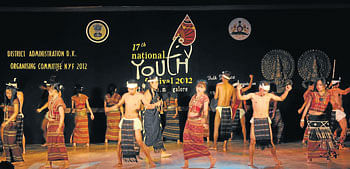Indian folk culture comes alive on dance floors
From ‘Sawalakia’ to ‘Dombarata,’ contestants mesmerise audience

Be it celebrating harvest or telling war-stories, Indians don’t lose an opportunity to narrate their experiences through dance. Dance is the first thing many associate with culture and at the 17th National Youth Festival, culture unfolded at the folk dance competition held at T M A Pai Hall on Saturday.
The competition started with a bang with the team from Mizoram performing their ancient dance ‘Sawalakia’. When the male dancers wore tribal costumes such as Duakala and Chynapao, the pretty ladies swayed with Kahori.
Speaking to Deccan Herald, A Beimohlu from Mizoram team said that Sawalakia is the popular dance of the Maras of South Mizoram. This is also called as the dance of the ‘spirit of the slain,’ he said. Earlier, the warriors believed that the dead bodies of the enimes possesed evil spirit hence, they used to dance around the slain heads with a ceremonial sword ‘Vainah,’ he adds.
Uttarakand remembered their war heroes with ‘Ran Bhoot Nritya’. The dance was a tribute to the heroes who sacrificed their lives in wars against invadors.
Team Bihar prepped up the mood with the ‘Kajari dance’. The dancers dressed in blue traditional attires. The ladies carried a ‘Ghada’ (Pot) and the men danced with the musical instrument ‘Dhaff’. The dance was presented by the members of Sadana Kala Kendra from Bihar. “We have practiced a lot for this performance. It is the fifth time we are visiting NYF. Kajari dance is performed, when it rains as a welcome to the rainy season,” they said.
Team Andhra Pradesh stole the show with their ‘Dombarata’ (a street dance). The dancers showed their street smartness with quick moves and even quicker somersaults. The team formed various formations, and performed complicated acrobatics driving the audience crazy.
‘Jo Bhole So Nihal’ echoed in the auditorium when the Punjabis stepped on the stage. The team who put up a splendid performance of Bhangra, were also joined by the audience who were all doing ‘Balle Balle’.
The costumes of team Meghalaya were a visual treat. The men dressed in deep blue and women dressed in bright green wore head dresses having cock feathers, when they danced ‘Wangala’.
“The dance is in honour of godess Sarjongmatay who blesses our food,” says dancer Tilbirth Sangamar.
Team Maharashtra presented ‘Pavrah,’ a folk dance formed in the Sahyadri region and spread all over Maharashtra. The dancers wore peacock feathers. The flute was played by a girl and Kapil Jadav played a unique instrument called Sundari, which is played only by the Jadav family.
The Chow Dance by the West Bengal team portrayed the ‘Mahisasura Nidhan’ incident. This mythological dance is performed in West Bengal with a hope of bringing peace and normalcy to the city.
Team Himachal Pradesh showed different professions of the people in the state with their dance ‘Gado Gadi’. The beautiful madiens of Jammu and Kashmir swayed gently with the traditional attires. The theme of their dance was a love story.
The Sikkim team performed the Gurum dance. Team Haryana performed a traditional harvest dance ‘Haryanvi’. The ladies in their glittering dresses carried hay symbolising harvest.
Deccan Herald is on WhatsApp Channels| Join now for Breaking News & Editor's Picks